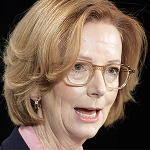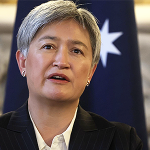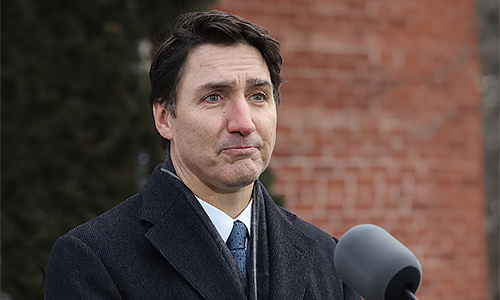The Bristol Museum and Art Gallery is one of those places that makes me feel uncomfortable. I feel picked-on even visiting the website. At the top of the screen – before any mention of the collections and exhibitions – we are all told that ‘Bristol Museums welcomes trans and gender-diverse visitors, volunteers and members of staff’.
Perhaps this is a response to the Supreme Court judgement that biological sex quite rightly takes precedence over paperwork when distinguishing women from men? But I find it unhelpful and intrusive. I might be transsexual, but I am a human being just like everyone else, and I don’t need special treatment.
I certainly don’t want images that appear to promote elective double mastectomy – mutilating surgery in other words – emblazoned on two giant murals three metres high on either side of the main entrance hall of the museum. This, after all, is a place where groups of primary school children gather to be briefed before being shown the various collections held by the city.
A post shared by Samo white (@mister.samo)
On the day I visited, I walked past a couple of dozen youngsters as they sat quietly on the floor in that hall under the supervision of three adults in high-viz jackets. The murals by Samo White (‘he/they’) a trans-identified artist from Southsea, had been installed to promote the current headline exhibition in the museum. According to Bristol Museums, ‘Gender Stories dives deep into the intricate connections between sex, gender, sexuality, and identity’. The blurb adds that ‘visitors to Gender Stories will explore pivotal questions’ such as ‘What is gender?’, ‘Who decides your gender?’ and ‘What is the future of gender?’
Personally, I’d be happy never hearing the word ‘gender’ again, but I thought I’d better have a look to find out what Bristol’s public museum service was promoting. The exhibition – in a separate ticketed area – was not an edifying experience. The focus was on oppression and the need for protection. There were lots of quotes from anonymous ‘community members’ that gave a sense of victimhood. ‘It just puts you on edge constantly not knowing if you will be the next to experience unwanted behaviour from others,’ said one.
One exhibit was even covered by a little shroud, presumably to protect the unwary from inadvertently viewing what was a pin badge with the message ‘Gender Hostile’. The accompanying poster encouraged visitors to ‘skip this if you don’t feel able to safely engage with these themes’. Those brave enough to continue reading were told that:
Gender critical feminists believe that sex is male or female and cannot change … This belief can be distressing and damaging for trans people and rejects their identities.
Following that rather infantilising message, we were then reassured that ‘Bristol Museums supports and stands in solidarity with our trans staff, partners and communities’.
More of White’s work was on show, and like the murals in the main entrance, the theme was human breasts underscored each time by those disturbing cuts and stitches. Were they mastectomy scars? White explained that the piece was a deep self-exploration of ‘my experiences and psyche as a transgender person’.
Alongside the paintings, photographs and pottery – a piece by Grayson Perry was prominent – pre-recorded video commentary by Dr Sarah Jones tried to explain what was going on with gender. Jones is a social and cultural historian of gender and sexuality at Bristol University. To be fair to her, she did a good job explaining what has, until now, been the orthodox narrative on gender. But just because something is widely believed does not make it true. To my ear, Jones sounded like a believer in the geocentric universe explaining the theory about how the sun goes round the earth.
The other key narratives – oppression and victimhood – permeated the exhibition. The solution on offer was clearly written on the wall. ‘The community is the antidote’, visitors were told, and:
If you don’t have the support you need [and] if any of the ideas explored today feel too much […] local and national organisations can provide help, unity and hope. Your community is there for you.
The language, the methods and the imagery – there was a space filled with shifting lights, colours and sounds in the exhibition to ‘recharge and heal’ – could have been taken straight from a religious cult on a recruitment drive. ‘You are loved’, we kept being told. From where else might we hear messages like that?
Art can be an educator, and sometimes it educates in a way that the creator did not anticipate. This exhibition certainly educated me. It left me with the distinct feeling that this is a cult and we need to be on our guard against it. The risk is not from society as a whole, but an activist lobby that appears to encourage victimhood and creates vulnerability. That’s no way to live.
Maybe others in the room had come to similar conclusions? But I didn’t ask. We were all under the beady eye of the museum staff and despite the ‘all are welcome here’ mantra, I got the feeling that heterodox views would be poorly received.
Times are changing fast, though, and in some ways this exhibition marked the great heresy of the past ten years – that gender identity trumps biological sex. Perhaps a museum is a good place for it? But in a closed area restricted to adults. Bristol museums’ recommended visitor age of 14+ included possibly impressionable youngsters.
The museum’s decision too to subject primary school children to White’s murals was unforgivable. Teachers bringing their classes to see the museum’s dinosaurs are expected to marshal their pupils under the gaze of disfigured images bearing White’s transgender experiences. You are loved? Not like this!










